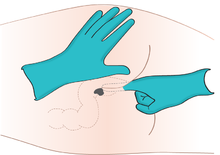Enteral administration



Enteral administration is food or
enteros 'intestine'.Forms
Enteral administration may be divided into three different categories, depending on the entrance point into the GI tract: oral (by mouth), gastric (through the stomach), and rectal (from the rectum). (Gastric introduction involves the use of a tube through the nasal passage (NG tube) or a tube in the belly leading directly to the stomach (PEG tube). Rectal administration usually involves rectal suppositories.)
| Oral administration | Rectal administration | |
Solids |
Liquids |
- |
Pill |
Solution | Ointment
|
| Tablet | Softgel | Suppository |
Time release technology |
Suspension | Enema |
Osmotic controlled release capsule |
Emulsion | Murphy drip |
| Syrup | Nutrient enema | |
| Elixir | ||
| Tincture | ||
| hydrogel | ||
Drug absorption from the intestine
The mechanism for drug absorption from the intestine is for most drugs passive transfer, a few exceptions include
lipid solubility.[2]
Factors influencing gastrointestinal absorption:
- Gastrointestinal motility.
- Splanchnic blood flow.
- Particle size and formulation.
- Physicochemical factors.
First pass metabolism
Drugs given by enteral administration may be subjected to significant
first pass metabolism
, and therefore, the amount of drug entering the systemic circulation following administration may vary significantly for different individuals and drugs. Rectal administration is not subject to extensive first pass metabolism.
See also
References
- ^ "Enteral administration - pharmacology". britannica.com. Retrieved 19 April 2018.
- ISBN 0-443-06911-5.





